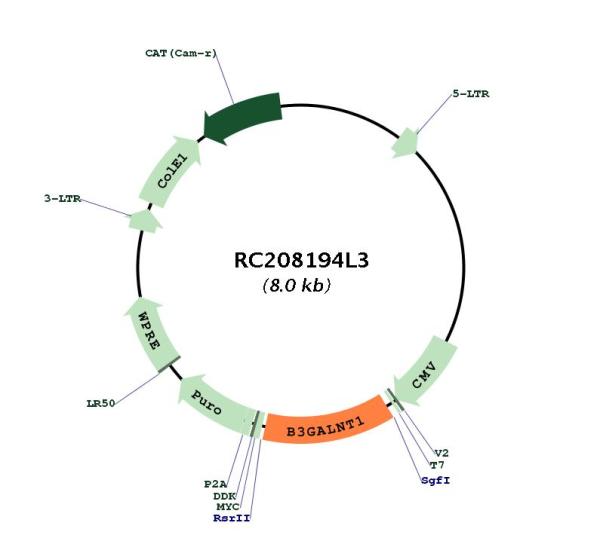RC208194L3
Scientist.com Supplier
B3GALNT1 (NM_033168) Human Tagged Lenti ORF Clone
Origene Technologies, Inc.
DESCRIPTION
Lenti-ORF clone of B3GALNT1 (Myc-DDK-tagged)-Human beta-1,3-N-acetylgalactosaminyltransferase 1 (globoside blood group) (B3GALNT1), transcript variant 3
DETAILS
- Mw: 39.5 kDa
- Tag: Myc-DDK
- Accn: NM_033168
- Type: Human Tagged ORF Clone
- Refseq: NM_033168.2, NP_149358.1
- Status: 3 Weeks*
- Symbol: B3GALNT1
- Vector: pLenti-C-Myc-DDK-P2A-Puro
- Category: cDNA Clones
- Locus Id: 8706
- Orf Size: 993 bp
- Synonyms: B3GALT3; beta3Gal-T3; galT3; Gb4Cer; GLCT3; GLOB; P; P1
- Refseq Orf: 996 bp
- Uniprot Id: O75752
- Refseq Size: 3224 bp
- Availability: 3 Weeks
- Cytogenetics: 3q26.1
- Gene Summary: This gene is a member of the beta-1,3-galactosyltransferase (beta3GalT) gene family. This family encodes type II membrane-bound glycoproteins with diverse enzymatic functions using different donor substrates (UDP-galactose and UDP-N-acetylglucosamine) and different acceptor sugars (N-acetylglucosamine, galactose, N-acetylgalactosamine). The beta3GalT genes are distantly related to the Drosophila Brainiac gene and have the protein coding sequence contained in a single exon. The beta3GalT proteins also contain conserved sequences not found in the beta4GalT or alpha3GalT proteins. The carbohydrate chains synthesized by these enzymes are designated as type 1, whereas beta4GalT enzymes synthesize type 2 carbohydrate chains. The ratio of type 1:type 2 chains changes during embryogenesis. By sequence similarity, the beta3GalT genes fall into at least two groups: beta3GalT4 and 4 other beta3GalT genes (beta3GalT1-3, beta3GalT5). The encoded protein of this gene does not use N-acetylglucosamine as an acceptor sugar at all. [provided by RefSeq, Mar 2017]
- Sequence Data: ORF Nucleotide Sequence ( show hide ) The ORF insert of this clone is exactly the same as(RC208194).
- Oti Annotation: This clone was engineered to express the complete ORF with an expression tag. Expression varies depending on the nature of the gene.
- Oti Disclaimer: The molecular sequence of this clone aligns with the gene accession number as a point of reference only. However, individual transcript sequences of the same gene can differ through naturally occurring variations (e.g. polymorphisms), each with its own valid existence. This clone is substantially in agreement with the reference, but a complete review of all prevailing variants is recommended prior to use. More info
- Reconstitution: 1. Centrifuge at 5,000xg for 5min. 2. Carefully open the tube and add 100ul of sterile water to dissolve the DNA. 3. Close the tube and incubate for 10 minutes at room temperature. 4. Briefly vortex the tube and then do a quick spin (less than 5000xg) to concentrate the liquid at the bottom. 5. Store the suspended plasmid at -20°C. The DNA is stable for at least one year from date of shipping when stored at -20°C.
- E Coli Selection: Chloramphenicol (34 ug/mL)
- Protein Families: Transmembrane
- Protein Pathways: Glycosphingolipid biosynthesis - globo series, Metabolic pathways
- Restriction Sites: SgfI-RsrII Cloning Scheme for this gene Plasmid Map
- Product Components: The ORF clone is ion-exchange column purified and shipped in a 2D barcoded Matrix tube containing 10ug of transfection-ready, dried plasmid DNA (reconstitute with 100 ul of water).
- Mammalian Cell Selection: Puromycin
